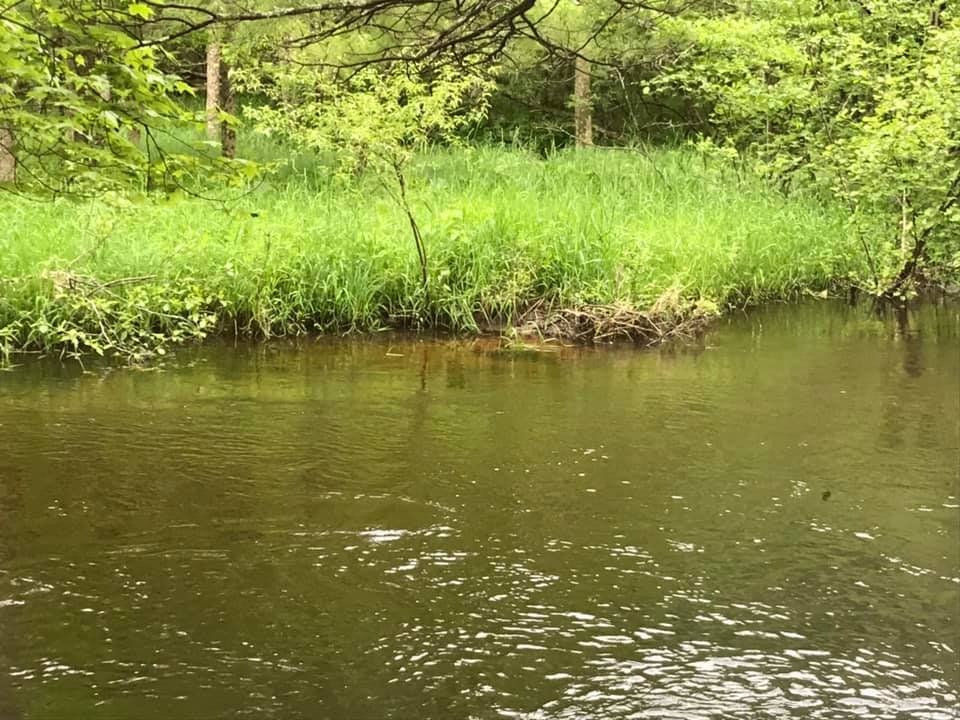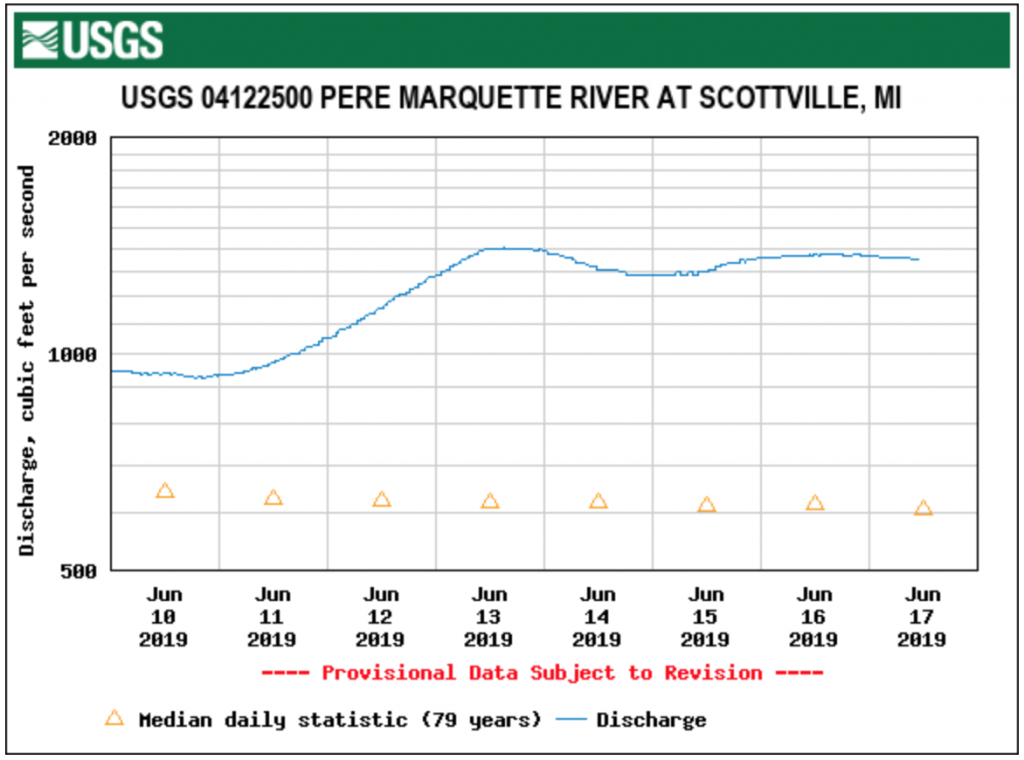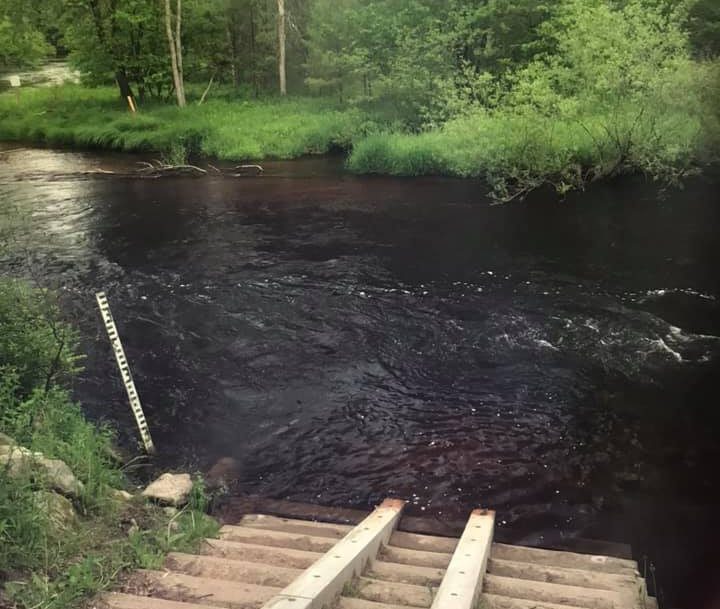
Every spring we experience high water from winter melt-off and continuous rainy days that seem to overwhelm our river. This year we have had a lot of rain late in the season that has kept water levels high. Many people are off-put by high flow rates, dark stained water, and gloomy rainy days and wonder if it’s worth fishing.
This guide will provide some tips and insights that will help you better understand how to read USGS flow data, stain of water, and upcoming weather conditions. With this information you can make better judgement calls on where to be fishing under certain conditions, what fishing techniques can up your chances with spring high water, where to fish in high water and, most importantly, help decide the answer to the question, “is it worth fishing today?”
FLOW RATES:
Each state records their streamflows and logs water data through flow gauges strategically placed on rivers throughout the state. Depending on the gauge and data relay system, river flow rates are real-time reports updated on 15-60 minute intervals. This data is collected and posted through the US Geological Survey (USGS) website. The flow is posted in cubic feet per second (CFS), which is a calculation of how much water is flowing by the gauge at any point in time. Without knowing a river’s seasonal averages as a point of reference, the CFS often means very little to most people. You can get a better idea of the average or even expected seasonal CFS rates by contacting your local fly shop or looking at the data logs on the USGS website for past seasons. Keep in mind that rates in spring may not be comparable to rates in fall. In addition to that, the average rates vary significantly from river to river.


A big tip for reading a gauge on your local river is to first know where your gauge is! Is the gauge in your river right where you fish or is it 50 miles downriver? (On the PM, the gauge is significantly down river in Scottville.) There is a lot of water in between the flies-only section of the river and where the gauge is located. When we first get a big rain the gauge might read under in Scottville compared to what is actually happening far up river in the flies-only section. On the flip side, it takes some time for the water to run off into the river and for the first big ‘push’ of water to reach the river from its contributing tributaries. Therefore, a day or two after a really big rain the gauge might actually read a much higher CFS rate at Scottville compared to the flies-only section. With this being said, water levels will be lower in the upper sections of the river and the lower sections of the river will be holding higher levels of water.
If you are interested, you can subscribe through this link to receive water alerts from the USGS. This will give you real time updates if the river is blown out or unsafe.
SAFETY:
This brings us to the question of when is it safe to float or wade in high water. Calling your local fly shops can oftentimes be the easiest way to find out if conditions are safe for floating or wading because they have guides on the water every day giving them updates. People often call and ask, “what CFS rate is safe for wading and at what point does it become unsafe for floating or wading?” This is tough because it is not the same for everyone! For the Pere Marquette River, our average spring flows range from about 900 CFS to 2000 CFS as a high. Further into the summer during our fry months we might see an average of 600 to 900 CFS. A month ago after our first few days of major rain the river was high over its banks with 2200 CFS. Regardless of what anyone tells you, ALWAYS use your best judgement to determine what is safe for you. One recommendation that I have given over time is that 1200 CFS is often safe for people to be getting in and out of boats easily, getting in and out of the river on the banks, and wade fishing. Crossing the river is often the most dangerous part for people, especially if you are unfamiliar with our river. At this rate generally you have a visibility of 3 to 4 feet. For most people this about waist-to-chest high water, so if you can’t see bottom, don’t walk there!
TACTICS OF HIGH WATER FISHING:
Now that we have a better understanding flow rates and high stained water we can then talk about how to be a more productive fisherman in these environments. During the spring we nymph, dry fly fish, and throw streamers. In higher water, nymph fishing and dry fly fishing can be less than ideal. The difficulty of nymphing in high water is getting the fly down to the bottom both quickly and accurately. Even when using a lot of weight this can be hard to achieve. In high water conditions and heavily stained water dry fly fishing can be very difficult as well because the fish are just not looking up to eat. Not only is the visibility low, but there are often a time an abundance of nymphs in the water for the fish to eat which keeps the fish nice and full. Fish will naturally take the path of least resistance when feeding taking. This makes streamer fishing the most practical and productive tactic of fly fishing in high water.
STREAMER FISHING:
In the months of March and April we have an abundance of steelhead eggs in the river as the main source of food for trout. In June and July we experience many of our bug hatches for dry fly fishing. With this being said, there is a period of time in between the eggs being in the river and when our dry fly hatches happen. During this ‘in between’ period of major food sources fish gorge on sculpin, leeches, salmon alvin/parr, and other small fish in the river which are imitated with different streamer patterns. Using these different patterns and changing our techniques we can still produce numbers and catch large fish even in the most intimidating of conditions. There are two major factors that are important to streamer fishing in high, stained water. First, make sure that you get your fly down fast enough. Second, make sure that your fly is visible to the fish. This can be done by choosing the right fly line and the right flies.

WHAT KIND OF LINE TO USE?
In general you can streamer fish with a floating line, a floating line with a polyleader sink tip, an intermediate sinking line, or most ideal, a heavy-grained full sink line. The full sink line is going to be your best bet for streamer fishing in most conditions, especially in any type of high water. Full sink lines often range from 100 grains up to 300 or 350 grains on the high side. Each grain is often associated with a sinking rate per second. Many of our guides use 300 grain sink tips year around for streamer fishing, but when fishing in high water having a heavy line is nothing less than essential. The best lines we carry at this time (in my opinion) is the Orvis Pro Depthcharge in a 300 grain or Airflo Streamer Max in a 280 grain. Each of these lines can be used to throw big flies comfortably on 7 and 8 wt rods.
What flies to use? Size and Colors
The most basic answer to this question might be to fish big and dark flies! The bigger the fly the easier it is to see in heavily stained water. The more ‘body’ the fly has the more movement it will have in its presentation. A few examples of this might be adding rubber legs, an articulation, or a little extra material to your fly patterns. While white, chartreuse, and other light colors can often be great for our river, in stained water darker flies can often work a little better. This is because lighter and flashier flies can oftentimes blend into the stain. Darker flies such as black, brown, and olive do a great job of creating a silhouette or shadow in the water which is easier for fish to see. For specific patterns stop in the fly shop and we would be happy to help you pick out some patterns best for that day’s conditions.
If you have any questions or comments about anything in this post please feel free to reach out to us at the shop at 231-745-3972 or email us at staff@pmlodge.com
Any of our shop employees are happy to help you get rigged up, find places to fish, or decide on what flies to use!
CFS LINKS TO OUR LOCAL RIVERS: